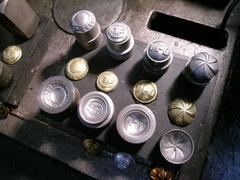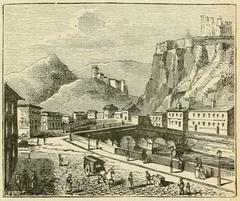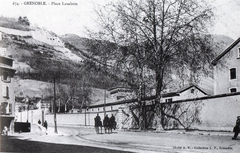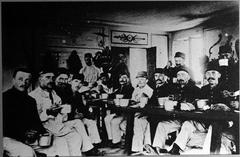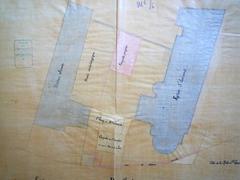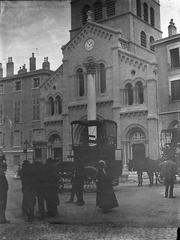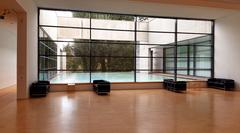L’Anneau De Vitesse: Complete Visitor Guide to Grenoble’s Historic Olympic Venue
Date: 14/06/2025
Introduction
L’Anneau de Vitesse, nestled in Grenoble’s Parc Paul Mistral, is both a celebrated symbol of Olympic heritage and a living example of urban renewal. Originally built as the speed skating rink for the 1968 Winter Olympics, it remains a focal point for sports, cultural events, and community gatherings. This guide delivers all you need to know about L’Anneau de Vitesse—including its history, architectural highlights, visitor information (opening hours and tickets), accessibility, and recommendations for nearby attractions.
Table of Contents
- Origins and Construction of L’Anneau de Vitesse
- The 1968 Winter Olympics: Historic Spotlight
- Evolution and Present-Day Use
- Key Architectural and Artistic Features
- Cycling and Community Activities
- Nearby Attractions in Grenoble
- Frequently Asked Questions (FAQ)
- Conclusion and Visitor Recommendations
- References and External Links
Origins and Construction of L’Anneau de Vitesse
Purpose-built for the 1968 Winter Olympics, L’Anneau de Vitesse was constructed in Grenoble’s Parc Paul Mistral, itself a product of early 20th-century urban planning. The oval track spans 400 meters and was engineered with an advanced refrigeration system—over 100 kilometers of embedded piping maintained the ice surface at -7°C, ensuring international competition standards in an outdoor setting (Wikipedia: Speed skating at the 1968 Winter Olympics). The venue seated about 2,500 spectators and included additional training lanes, blending seamlessly into the park’s green expanse (Ville de Grenoble – Anneau de Vitesse).
The 1968 Winter Olympics: Historic Spotlight
During February 1968, L’Anneau de Vitesse hosted all Olympic speed skating events, drawing competitors from nineteen nations and witnessing one world record and six Olympic records (Wikipedia: Speed skating at the 1968 Winter Olympics). The venue was a hallmark of Grenoble’s modernization, helping transform the city’s infrastructure and global reputation.
Evolution and Present-Day Use
Post-Olympic Adaptation
After the Olympics, the rink continued to host ice sports and public skating sessions into the late 1980s. As maintenance costs rose, the refrigeration system was eventually dismantled. The site then transitioned to a year-round, multi-use space supporting rollerblading, cycling, walking, and cultural activities—reflecting Grenoble’s commitment to sustainability and active city life.
Visiting Hours
- General Access: L’Anneau de Vitesse is open year-round, aligned with Parc Paul Mistral’s hours:
- 6:30 AM to 10:00 PM (may vary seasonally).
- Special Events: Hours may extend for concerts or festivals; check event calendars for updates (OMS Grenoble event calendar).
Tickets and Access
- General Entry: Free of charge for all visitors.
- Ticketed Events: Certain concerts, festivals, or guided tours may require advance booking or paid tickets. Visit the OMS Grenoble event calendar or onsite kiosks for details.
Getting There and Accessibility
- Location: 18 boulevard Clemenceau, Parc Paul Mistral, Grenoble.
- Public Transport: Easy access via tram line A (‘Paul Mistral’ stop) and multiple bus routes.
- Parking: Onsite and nearby parking available.
- Accessibility: The venue is fully accessible, featuring ramps, barrier-free paths, and adapted amenities for visitors with disabilities (Sport en France).
Key Architectural and Artistic Features
L’Anneau de Vitesse is an exemplar of 1960s engineering and design. Its vast concrete base, once home to a pioneering refrigeration system, is now used for roller sports and cycling. The grandstands, constructed with reinforced concrete, offer unobstructed views and accessibility.
A highlight is the monumental “Anneaux Olympiques” by Victor Vasarely, an iconic work of Olympic public art that remains a rare and celebrated feature of the site (Le Dauphiné). The structure’s integration with the park landscape reflects the period’s architectural focus on harmony between built and natural environments.
Cycling and Community Activities
Embracing Grenoble’s Cycling Culture
Grenoble is recognized as one of France’s leading cities for cycling, with L’Anneau de Vitesse at the heart of this movement. The venue’s open design and smooth surface make it ideal for rollerblading, skateboarding, and cycling. Seasonal events, roller nights, and athletic competitions are held regularly (OMS Grenoble).
École du Vélo de Grenoble (EVG)
Launched in 2023, the EVG operates beneath the grandstands, offering:
- Savoir Rouler à Vélo (SRAV): Road safety and cycling skills for children.
- Adult Refresher Courses: (Launching soon) for adults returning to cycling.
- Inclusive Programs: Adapted bikes and instruction for people with disabilities.
The school supports a fleet of 70 bikes and a team of dedicated staff (Ville de Grenoble – École du Vélo de Grenoble).
Nearby Attractions in Grenoble
While visiting L’Anneau de Vitesse, explore these nearby sites:
- Tour Perret: Historic observation tower with city views.
- Stade des Alpes: Modern stadium for football and rugby.
- Bastille Fortress: Accessible by cable car, offering panoramic Alpine vistas.
- Musée de Grenoble: One of France’s premier art museums.
- Grenoble’s Old Town: Medieval streets and lively cafés.
These attractions make Parc Paul Mistral and its surroundings a rich destination for history, art, and leisure (PlanetWare).
Frequently Asked Questions (FAQ)
Q: What are L’Anneau de Vitesse’s opening hours?
A: Generally 6:30 AM to 10:00 PM, following Parc Paul Mistral’s schedule.
Q: Is there an admission fee?
A: No—general entry is free. Some events may require tickets.
Q: How do I get there?
A: Use tram line A (‘Paul Mistral’ stop), bus, bike, or car.
Q: Is the site accessible to people with disabilities?
A: Yes; ramps, barrier-free paths, and adapted equipment are available.
Q: Are guided tours available?
A: Guided tours and group visits can be arranged during special events or through the city’s cultural office.
Q: Which nearby attractions are recommended?
A: Tour Perret, Bastille Fortress, Musée de Grenoble, and Grenoble’s Old Town.
Conclusion and Visitor Recommendations
L’Anneau de Vitesse is a vibrant blend of Olympic legacy, architectural innovation, and community activity. With free year-round access, robust cycling and roller sports programs, and a dynamic calendar of cultural events, it serves both locals and tourists as a model of urban transformation and active living. For the best experience:
- Check the OMS Grenoble event calendar for up-to-date schedules.
- Visit during the early morning or evening for the best light and atmosphere.
- Explore nearby historical and cultural attractions for a full Grenoble experience.
- Download the Audiala app for personalized guides, audio tours, and real-time updates.
Whether you seek Olympic history, active recreation, or cultural enrichment, L’Anneau de Vitesse is a must-see landmark in Grenoble.
References and External Links
- Wikipedia: Speed skating at the 1968 Winter Olympics
- Ville de Grenoble – Anneau de Vitesse
- OMS Grenoble event calendar
- Le Dauphiné – Cultural and Preservation Insights on Anneau de Vitesse
- Ville de Grenoble – École du Vélo de Grenoble
- Sport en France
- PlanetWare – Tourist Attractions in Grenoble
